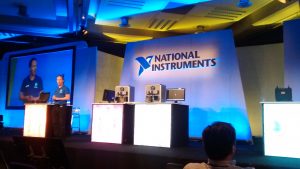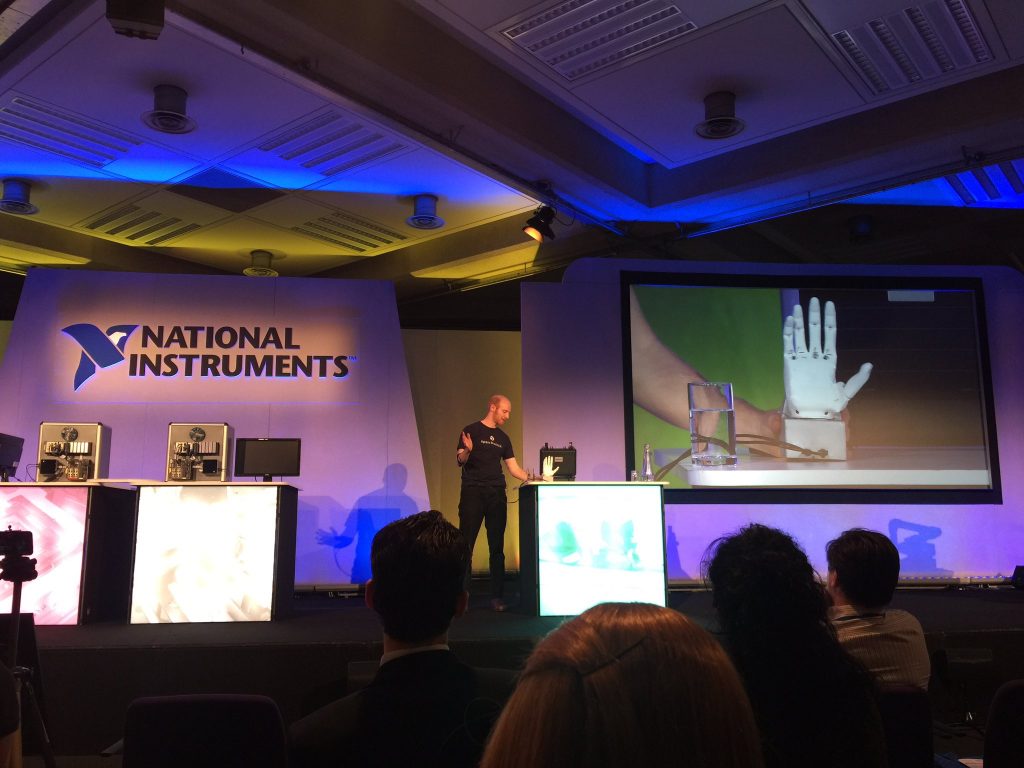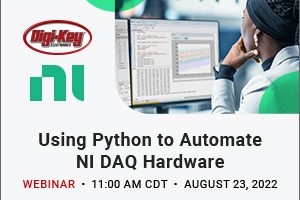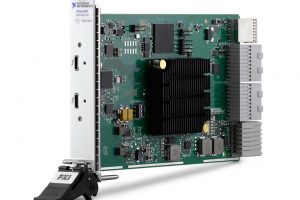 “What keeps you engaged with engineering and science?”, asked Richard Roberts, Academic Marketing Engineer at NI. His answer was their ability to help create the future, and the keynote certainly offered plenty of evidence of people working for a better future.
“What keeps you engaged with engineering and science?”, asked Richard Roberts, Academic Marketing Engineer at NI. His answer was their ability to help create the future, and the keynote certainly offered plenty of evidence of people working for a better future.
With an example trend being the development of Industrial IoT and time sensitive networking (see NIDays 2016: Industrial IoT routes itself into Time Sensitive Networking for fuller details), and the technology being the introduction of the NI Software Technology Preview (see boxout below), it was the “people” element of the equation that undoubtedly made it the most engaging segment.
First we heard about six of the finalists chosen from NI’s 2016 Student Design competition (see the videos below).
For example, there was the Aarhus University School of Engineering’s Deep Freeze ROV, an underwater robot for arctic research.
The challenge was to study ice algae to better understand the Arctic environment and study dynamic effects in this area. The resulting system was a lightweight, highly-manoeuvrable, aquatic inspection robot, ready for under-ice deployment in Greenland (a myRIO runs a real-time LabVIEW program which constantly sends and receives data from and to the operating computer).
From the Technical University of Denmark there was an entry in the Shell Eco-Marathon in 2015 which managed to break records for fuel efficiency. Specifically, their eco-car Stratos II+ broke the world record for urban-class cars with combustion engines by achieving 665km/L (a CompactRIO helped automate the fuelling process). This represents going the length of the UK on two litres of fuel, it was pointed out.
There was also the entry, from University of Leeds, for Project ALAN and its concept of robotics-enabled remote physiotherapy. The team has built a commercially-viable rehabilitation device and also developed a testing system using a humanoid arm to replicate the movement of a patient (using LabVIEW, myRIO and CompactRIO). There’s also support for live consultations with remote physiotherapists.
Open Bionics
Continuing on the theme of artificial limbs and technological support, the main speaker in the keynote was Joel Gibbard, the CEO and co-founder of Open Bionics.
He believes that technology with “a little bit of creativity and playfulness can change people’s lives for the better”. And he uses open source design and 3D printing to achieve this, not only reducing the cost of production but also opening up design possibilities.
Gibbard has pioneered a new way of making prosthetic arms with custom fitted bionic hands using 3D printing, which we saw in action. He traced his inspiring progress, from the crowdfunding for the Dextrus Open Hand Project, through to the development and growth of Open Bionics and its “next generation of bionic hands”.
“The best robotics can be really creepy, to first look at,” he said, but the long term human benefits are obvious.
He quoted the estimation that 11 million people in the world are potentially in need of prosthetic or bionic supports. Given the current expense of the technologies, however, less than one percent are liable to have access to such limbs. Open Bionics is working to change this, and very inspiring it was to hear.
Gibbard believes such new approaches can “remove the stigma associated with prosthetics by turning them into a positive talking point, for example the Iron Man, Frozen and Star Wars inspired prosthetics for children that they developed in cooperation with Disney”.
He also emphasised the value of an open approach, and the cheaper price point that can result.
“Sharing designs online enabled hackers and makers to get involved, in a collaborative effort. This lead to a fully 3D-printed bionic hand which was affordable for various university and research institutions to pick up the design – for £600 – and start working on the system themselves…”
The company is recruiting.
For more information on NIDays 2016, National Instrument’s Graphical System Design Conference, see http://uk.ni.com/nidays. The event was held at the Queen Elizabeth II Conference Centre in London, on 29 November.
NI Software Technology Preview
The National Instruments Software Technology Preview is a programme to give customers early access to NI’s platforms and technology, along with an opportunity to give feedback.
For example, during the keynote Elijah Kerry – Principal Product Manager for Software at NI – demonstrated forthcoming native browser support for building VIs (virtual instrumentation) via the generation of standard javacript. This code can itself be modified to include third-party elements such as from YouTube or twitter.
The company writes:
The NI Software Technology Preview provides current users of NI software active on a Standard Service Program contract with an early look at conceptual capabilities. Help ensure features currently in development are most useful for your application needs.
In addition, supporting content such as guides, reference materials, help modules, and discussion forums are available to help you along the way.
Note that you have to apply online. The URL for more information about the NI Software Technology Preview is www.ni.com/en-gb/support/software-technology-preview.html
 Electronics Weekly Electronics Design & Components Tech News
Electronics Weekly Electronics Design & Components Tech News




